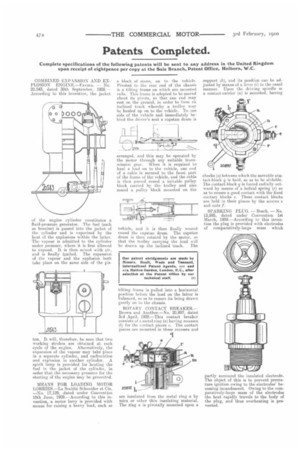Patents Completed.
Page 20

If you've noticed an error in this article please click here to report it so we can fix it.
Complete specifications of the following patents will be sent to any address in the United Kingdom upon receipt of eightpence per copy at the Sale Branch, Patent Office, Holborn, COMBINED EXPANSION AND EXPLOSION ENGINE.—Favata. No. 20,543„ dated 30th September, 1308.— According to this invention, the jacket
of the engine cylinder constitutes a fluid-pressure generator. The fuel (such as benzine) is passed into the jacket of the cylinder and is vaporized by the heat of the explosions within the latter. The vapour is admitted to the cylinder under pressure, where it is first allowed to expand. It is then mixed with air, and is finally ignited. The expansion of the vapour and the explosion both take place on the same side of the pis
ton. It will, therefore, be seen that two working strokes are obtained at. each cycle of the engine. Alternatively, the expansion of the vapour may take place in a separate cylinder, and carburation and explosion in another cylinder. A spirit, lamp is provided for heating the fuel in the jacket of the cylinder, in order that the necessary pressure for the starting of the engine may he generated.
MFIA.NS FOR LOADING NIOTOR LORRIES.—La Sociati Schneider et Cie. —No. 17,129, dated under Convention 10th June, 1909.—According to this invention, a motor lorry is provided with means for raising A heavy load, such as
a block of stone, on to the vehicle. Pivoted to the rear end of the chassis a tilting frame on which are mounted rails. This frame is adapted to be moved about its pivots, so that one end may rest on the ground, in order to form an inclined track whereby a trolley may be hauled up on to the vehicle. To one side of the vehicle and immediately behind the driver's seat a capstan drum is arranged, and this may he operated by the motor through any suitable transmission gear. When it is required to haul a load on to the vehicle, one end of a cable is secured to the front part of the frame of the vehicle, and the cable is then passed round a suitable pulley block carried by the trolley and also round a pulley block mounted on the
vehicle, and it is then finally wound round the capstan drum. The capstan drum is then rotated by the motor, so that the trolley carrying the load will
ha drawn up the inclined track. The ilting frame is pulled into a horizonta iosition before the load on the latter is balanced, so as to ensure its being drawn gently on to the chassis.
ROTARY CONTACT BREAKER.-Brown and Another.—No. 20,897, dated 3rd April, 1909.—This contact breaker consists of a metal ring (a) having recesses fii) for the contact pieces c. The contact pieces are mounted in these recesses and are insulated from the metal ring a. by mica or other thin insulating material. The ring a is pivotally mounted upon a support (A), and its position can be adjusted by means of a lever (i) in the usual manner. Upon the driving spindle m a contact-carrier (a) is mounted, havihg cheeks (o) between which the movable contact-block q is held, so as to be slidahle. The contact-block is forced radially outward by means of a helical wring (r) so as to ensure a good contact with the fixed contact blocks c. These contact blocks are held in their places by the screws e and nuts f.
SPARKING PLUG. — Bosch. — No. 15,985, dated under Convention let March, 1909.—According to this invention the plug is provided with electrodes of comparatively-large mass which
partly surround the insulated electrode. The object of this is to prevent premature ignition owing to the electrodes' becoming incandescent. Owing to the comparatively-large mass of the electrodes the heat rapidly travels to the body of the plug, and thus overheating is prevented.




















